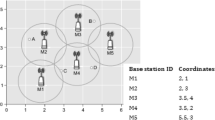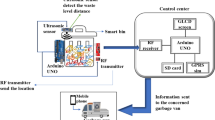Abstract
Opportunistic network (OppNet) is described as one of the most challenging network models, since contact between nodes is intermittent. In OppNet, an end-to-end path between the source and the destination does not exist because of nodes mobility. Therefore, relay nodes store then transmit the packets whenever a connection is available. Thus, store-carry-forward is the technique that allows OppNet to deliver messages from source to destination. One of the main drawbacks of this technique is the buffer congestion. Due to the unavailability of continuous connection between nodes, the message might stay in buffer’s nodes for a long period without being transmitted, which will lead to buffer overload. Several routing algorithms have been studied in order to manage the buffer’s nodes. In this paper, a novel adaptive buffer management policy that takes into consideration the limited network resources such as energy and bandwidth is proposed. The new solution relying on three policies; blacklisting, scheduling and dropping is capable to adapt with the modification of several network parameters such as message size, node capacity and network density. The simulation results show that the proposed solution improves the performance of OppNet by increasing the delivery rate and decreasing the network resource consumption.


























Similar content being viewed by others
References
Keranen, A. (2008). Opportunistic network environment simulator. Helsinki: Department of Communications and Networking.
Amirthavalli, R., Dhaya, R., & Chandrasoodan, M. (2016). A survey of routing algorithms in delay tolerant networks. In 2nd International Conference on Applied and Theoretical Computing and Communication Technology, Chennai.
Jain, S., & Chawla, M. (2014). Survey of buffer management policies for delay tolerant networks. The Journal of Engineering, 3, 117–123.
Prabha, C., Kumar, S., & Khanna, R. (2016). Analysis of routing and forwarding protocols in opportunistic networks. In International Conference on Computational Modeling and Security (CMS 2016), India.
Ahmed, K., Omar, M., & Hassan, S. (2016). Survey and comparison of operating concept for routing. Journal of Computer Sciences, 12, 141–152.
Kaur, N., & Mathur, G. (2016). Opportunistic networks: A review. IOSR Journal of Computer Engineering, 18(2), 20–26.
Nayyar, A., Batt, R. S., Ha, D. B., & Suseendran, G. (2018). Opportunistic networks: Present scenario—A mirror review. International Journal of Communication Networks and Information Security, 10(1), 223–241.
Vahdat, A., & Becker, D. (2000). Epidemic routing for partially-connected ad hoc networks. Durham, NC: Department of Computer Science, Duke University.
Lindgren, A., Doria, A., & Schelen, O. (2003). Probabilistic routing in intermittently connected networks. ACM SIGMOBILE Mobile Computing and Communications Review, 7, 19–20.
Spyropoulos, T., Psounis, K., & Raghavendra, C. S. (2005). Spray and wait: An efficient routing scheme for intermittently connected mobile networks. In ACM SIGCOMM Workshop on Delay-Tolerant Networking (pp. 252–259).
Burgess, J., Gallagher, B., Jensen, D., & Levine, B. N. (2006). MaxProp: Routing for vehicle-based disruption-tolerant networks. In Infocom (pp. 1–11).
Ayub, Q., Zahid, S. M., Rashid, S., & Abdullah, A. H. (2012). Adaptive message size routing strategy for delay tolerant network. Scientific Research and Essays, 7, 1798–1808.
Nafila, S. P., Yovita, L. V., & Perdana, D. (2016). Performance comparison of DTN routing protocol maxprop and spray and wait under varying node speed and volume. E-Proceeding of Engineering, 3(1), 181–186.
Rani, A., Rani, S., & Bindr, H. S. (2014). Performance evaluation of MOFO buffer management technique with different routing protocols in DTN under variable message buffer size. International Journal of Research in Engineering and Technology, 3(3), 82–86.
Sobin, C. (2016). An efficient buffer management policy for DTN. Procedia Computer Science, 93, 309–314.
Zhang, Y., Wang, H., Feng, G., & Lv, H. (2015). A fuzzy ranking based buffer replacement strategy for opportunistic networks. In Eighth International Conference on Internet Computing for Science and Engineering (ICICSE), Harbin.
Ke, M., Nenghai, Y., & Bin, L. (2010). A new packet dropping policy in delay tolerant network. In IEEE 12th International Conference on Communication Technology, Nanjing.
Ayub, Q., Ngadi, A., Raghid, S., & Habib, H. A. (2018). Priority queue based reactive buffer management policy for delay tolerant network under city based environments. PLoS One, 14(10), e0224826.
Yan, Y., Chen, Z., Wu, J., Wang, L., Liu, K., & Wu, Y. (2019). Effective data transmission strategy based on node socialization in opportunistic social networks. In IEEE Access.
Yoon, J., Kim, S. K., Lee, J. Y., & Jang, K. Y. (2017). An enhanced friendship-based routing scheme exploiting regularity in an opportunistic network. In Proceedings of the IEEE International Conference on Internet of Things, China.
Sharma, D. K., Dhurandher, S. K., Woungang, I., Bansal, A., & Gupta, A. (2018). A genetic algorithm based dynamic context aware routing protocol for opportunistic networks. In Proceedings of the International Conference on Network-Based Information Systems, Slovakia.
Massri, K., Vitaletti, A., Vernata, A., & Chatzigiannakis, I. (2016). Routing protocols for delay tolerant networks: A reference architecture and a thorough quantitative evaluation. Journal of Sensor and Actuator Networks, 5, 1–28.
Author information
Authors and Affiliations
Corresponding author
Additional information
Publisher’s Note
Springer Nature remains neutral with regard to jurisdictional claims in published maps and institutional affiliations.
Rights and permissions
About this article
Cite this article
Khalil, A., Abou Haidar, ., Bassil, G. et al. Adaptive Resource Management Solution for Ad-Hoc Opportunistic Networks. Wireless Pers Commun 117, 1931–1958 (2021). https://doi.org/10.1007/s11277-020-07952-5
Accepted:
Published:
Issue Date:
DOI: https://doi.org/10.1007/s11277-020-07952-5




